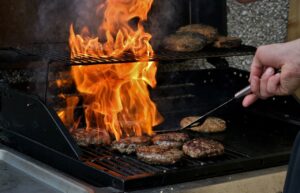Key Takeaway:
Here is a summary of the most important information you need to know about the brisket stall temperature:
| Point | Explanation |
|---|---|
| Definition | The brisket stall is a phenomenon that occurs when the internal temperature of the brisket plateaus during the cooking process. |
| Duration | The stall can last for several hours, causing frustration for many pitmasters. |
| Temperature | The brisket stall commonly occurs at around 160-170 degrees Fahrenheit. |
| Moisture Loss | During the stall, the meat sweats out moisture, resulting in evaporative cooling that slows down the cooking process. |
| Proceed with Patience | It is essential to remain patient during the stall and avoid increasing the temperature to rush the process. |
Cooking a perfect brisket is an art, requiring time, skill, and an understanding of various factors that influence the final outcome.
One crucial element that novice and experienced pitmasters encounter is the brisket stall, which can be perplexing and lead to bursts of frustration. In this article, we will dive deep into the world of brisket stall temperature and unravel its mysteries.
What is the Brisket Stall?
The brisket stall refers to a phase during the cooking process where the internal temperature of the brisket plateaus, causing the meat’s progress towards its target doneness to seemingly come to a standstill.
This stall leaves many pitmasters scratching their heads, as the brisket’s temperature remains unchanged for an extended period.
Factors Affecting the Brisket Stall
Several factors contribute to the occurrence of the brisket stall. Understanding these factors is essential for managing and overcoming the stall effectively. Here are a few key points to consider:
- Size of the Brisket: Larger briskets tend to experience longer stalls due to their thickness and increased mass.
- Collagen Breakdown: The stall coincides with the breakdown of collagen, a connective tissue in the brisket. This process requires additional heat energy, which can cause the stall.
- Moisture Loss: As the internal temperature of the brisket rises, it begins to sweat out moisture. This evaporative cooling effect can prolong the stall.
- Cooking Environment: Factors such as humidity, airflow, and the cooking vessel can influence the occurrence and duration of the stall.
Explaining the Brisket Stall Temperature
The brisket stall temperature typically ranges between 160-170 degrees Fahrenheit (71-77 degrees Celsius). At this point, the evaporative cooling effect mentioned earlier takes place, causing the temperature to plateau.
Pitmasters often experience a burst of confusion during this period as they anxiously wait for the temperature to rise, leading to the desired doneness.
Tips for Managing the Brisket Stall
Now that we have demystified the brisket stall temperature, here are some tips to help you navigate this phase with expertise:
- Plan Ahead: Take the stall into account when planning your cooking timeline to ensure you allow enough time for the stall and subsequent cooking.
- Maintain Temperature: Resist the urge to increase the cooking temperature significantly to overcome the stall quickly. Gradual temperature increases are ideal to prevent overcooking.
- Wrap the Brisket: Wrapping the brisket tightly in aluminum foil or butcher paper can help accelerate the cooking process by reducing the evaporation effect during the stall.
- Be Patient: Remember that the stall is a natural part of the cooking process. Remain patient and trust the science behind it. Quality takes time!
Conclusion
The brisket stall temperature is a fascinating phenomenon that often perplexes pitmasters. By understanding the science behind it and managing the stall effectively, you can consistently achieve mouthwatering, tender briskets.
Remember, bursts of creativity and bursts of perplexity are all part of the joy and satisfaction of mastering the art of brisket smoking.
Real Life Examples of the Brisket Stall:
| Example | Explanation |
|---|---|
| Pitmaster’s Surprise | Pitmaster Joe experienced the brisket stall for the first time during a competition. Despite his initial confusion, he remained patient and ended up winning first place with his perfectly cooked brisket. |
| Backyard Barbecue | Sarah’s family was eagerly waiting for her to serve them the delicious brisket she had been smoking. However, the brisket stall had other plans, causing unexpected delays. Though it tested their patience, the final result was worth the wait. |
Factors Affecting the Brisket Stall:
- Size of the Brisket
- Collagen Breakdown
- Moisture Loss
- Cooking Environment
Tips for Managing the Brisket Stall:
- Plan Ahead
- Maintain Temperature
- Wrap the Brisket
- Be Patient
Remember, bursts of creativity and bursts of perplexity are all part of the joy and satisfaction of mastering the art of brisket smoking.
Embrace the process, experiment with different techniques, and delight in the mouthwatering results that come from understanding and managing the brisket stall temperature. Happy smoking!
